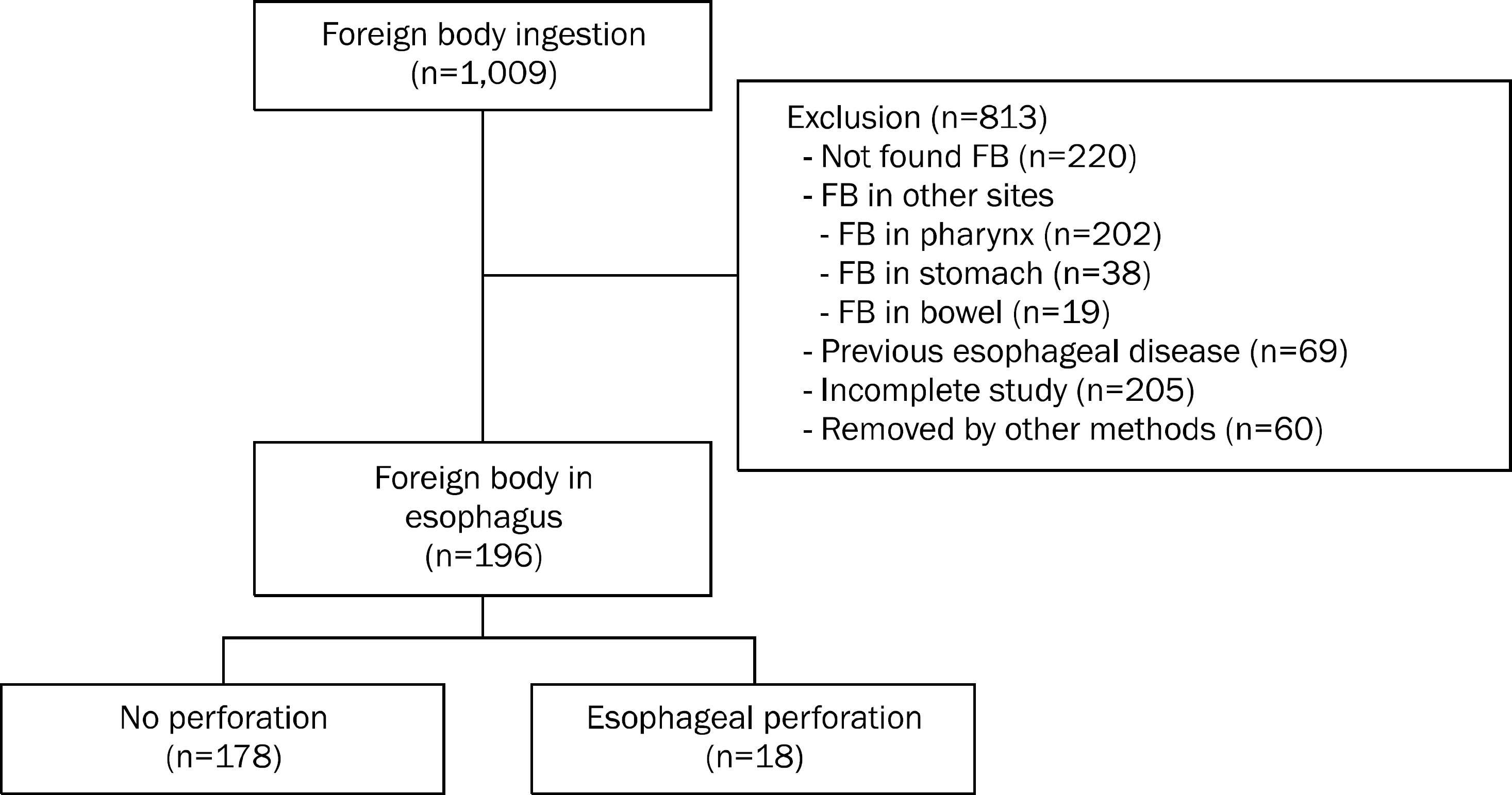Abstract
Background/Aims
Esophageal perforation is a rare but often a life-threatening condition. However, the incidence and clinical features of esophageal perforation caused by ingested foreign body are unknown. This study investigated the incidence of esophageal perforation caused by ingested foreign body and evaluated the clinical features and outcome of patients with esophageal perforation.
Methods
Among a total of 196 adult patients with confirmed esophageal foreign body and complained of at least one of the related symptoms at the emergency department between January 2000 and July 2008, 18 patients with esophageal perforation due to esophageal foreign body ingestion were included in the study. Data were collected by retrospectively reviewing the electric medical records.
Results
The incidence of esophageal foreign body and esophageal perforation in adults was 19.4% (196/1,009) and 1.8% (18/1,009), respectively. Chest pain was the most common symptom and fishbone was the most common foreign body causing esophageal perforation. Mediastinitis or mediastinal abscess occurred in 13 patients (13/18, 72.2%). About half (8/18) of the patients were admitted to the intensive care unit but there was no in-hospital mortality.
Conclusions
The incidence of esophageal perforation in patients with foreign body ingestion was low but it increased up to 9.2% in patients with esophageal foreign body. However, prognosis was favorable with timely proper treatment. Chest pain can be an ominous sign indicating the presence of esophageal perforation in patients with esophageal foreign body.
Go to : 
References
1. Ahmad R, Ishlah W, Shaharudin MH, Sathananthar KS, Norie A. Posterior mediastinal abscess secondary to esophageal perforation following fish bone ingestion. Med J Malaysia. 2008; 63:162–163.
2. Bufkin BL, Miller JI Jr, Mansour KA. Esophageal perforation: emphasis on management. Ann Thorac Surg. 1996; 61:1447–1451. discussion 1451–1452.

3. Abbas G, Schuchert MJ, Pettiford BL, et al. Contemporaneous management of esophageal perforation. Surgery. 2009; 146:749–755. discussion 755–756.

4. Søreide JA, Konradsson A, Sandvik OM, Øvrebø K, Viste A. Esophageal perforation: clinical patterns and outcomes from a patient cohort of Western Norway. Dig Surg. 2012; 29:494–502.

5. Pla V, Cuesta MA, van den Broek WT. Treatment of thoracic esophageal perforations. Cir Esp. 2005; 77:327–331.
6. Sung SW, Park JJ, Kim YT, Kim JH. Surgery in thoracic esophageal perforation: primary repair is feasible. Dis Esophagus. 2002; 15:204–209.

7. Salo JA, Isolauri JO, Heikkilä LJ, et al. Management of delayed esophageal perforation with mediastinal sepsis. Esophagectomy or primary repair? J Thorac Cardiovasc Surg. 1993; 106:1088–1091.

8. Lee SH, Seo SU, Choi SK, et al. A case of successful conservative treatment of esophageal perforation from penetration of esophageal wall by a fish bone. J Korean Geriatr Soc. 2009; 13:43–48.

9. Van Weyenberg SJ, Stam FJ, Marsman W. Successful endoscopic closure of spontaneous esophageal rupture (Boerhaave syndrome). Gastrointest Endosc. 2014; 80:162.

10. Geraci G, Raffaele F, Modica G, Sciumè C. Endoscopic palliative management of esophageal and tracheal rupture. Endoscopy. 2014; 46(Suppl 1 UCTN):E581–E582.

11. Sung SH, Jeon SW, Son HS, et al. Factors predictive of risk for complications in patients with oesophageal foreign bodies. Dig Liver Dis. 2011; 43:632–635.

12. Peters NJ, Mahajan JK, Bawa M, Chabbra A, Garg R, Rao KL. Esophageal perforations due to foreign body impaction in children. J Pediatr Surg. 2015; 50:1260–1263.

13. Chen T, Wu HF, Shi Q, et al. Endoscopic management of impacted esophageal foreign bodies. Dis Esophagus. 2013; 26:799–806.

14. Balci AE, Eren S, Eren MN. Esophageal foreign bodies under cricopharyngeal level in children: an analysis of 1116 cases. Interact Cardiovasc Thorac Surg. 2004; 3:14–18.

15. Nadir A, Sahin E, Nadir I, Karadayi S, Kaptanoglu M. Esophageal foreign bodies: 177 cases. Dis Esophagus. 2011; 24:6–9.

16. Søreide JA, Viste A. Esophageal perforation: diagnostic workup and clinical decision-making in the first 24 hours. Scand J Trauma Resusc Emerg Med. 2011; 19:66.

17. Onat S, Ulku R, Cigdem KM, Avci A, Ozcelik C. Factors affecting the outcome of surgically treated non-iatrogenic traumatic cervical esophageal perforation: 28 years experience at a single center. J Cardiothorac Surg. 2010; 5:46.

18. Mackler SA. Spontaneous rupture of the esophagus; an experimental and clinical study. Surg Gynecol Obstet. 1952; 95:345–356.
19. Riffat F, Cheng A. Pediatric caustic ingestion: 50 consecutive cases and a review of the literature. Dis Esophagus. 2009; 22:89–94.

20. Cheng HT, Cheng CL, Lin CH, et al. Caustic ingestion in adults: the role of endoscopic classification in predicting outcome. BMC Gastroenterol. 2008; 8:31.

Go to : 
Table 1.
Clinical Characteristics of Patients with Esophageal Perforation
Table 2.
Characteristics of Foreign Body
Table 3.
Result of Esophageal Perforation
| Result | Value |
|---|---|
| Treatment | |
| Surgery | 8 (44.4) |
| Conservative treatment | 10 (55.6) |
| Delayed complication | 3 (16.7) |
| Length of hospital stay (day) | 11 (6–27) |
Table 4.
Summary of Eighteen Patients with Esophageal Perforation




 PDF
PDF ePub
ePub Citation
Citation Print
Print



 XML Download
XML Download